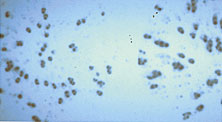Return to Genesis by Lois Goglia & Grain by Janet Passehl Exhbit Info
ARTIST'S STATEMENT
Genesis, Lois Goglia

Genesis is a series of eighteen collages created
from exposed X-ray film. These images are wall mounted, illuminated
on light boxes. They chronicle the beginning of life from the growth
of individual cells in petri dishes to the development of a full-term
fetus. DNA sequencing gels, human and animal X-rays, a mammogram, and
fetal ultrasound radiographs are incorporated into this work.
Apart from the broader social and bio-ethical content this artwork implies,
these collages also explore the X-ray's relationship to photography,
an art historical issue that, to my knowledge, has never been thoroughly
examined.
Genesis is the result of a number of synchronous
events that occurred this past spring. A Yale Medical School physician/researcher
who had seen my antecedent artwork that incorporated X-rays, furnished
me with films which been exposed to radioactive DNA. These images were
generated when film was placed adjacent to petri dishes covered with
bacteria. This researcher also supplied me with the DNA sequencing gels
that I have used throughout this series. These films are relatively
rare because this method of record keeping, although used just a few
years ago, is already obsolete. Furthermore, scientists who have used
X-rays for documenting their research have either discarded their films,
or are keeping them as records of earlier work. The human and animal
X-rays, a mammogram, and fetal ultrasound radiographs were donated by
medical health care professionals only with the promise that no personal
identifying labels would be left on the artwork.
Studying artworks which emphasized documentation, repetition, and serial progression in the Noncomposition: fifteen case studies exhibition at The Wadsworth Atheneum in Hartford, Connecticut to write a review for Art New England's April/ May 2002 issue gave me the impetus to present the DNA and petri dish images in a straightforward manner.
The collages from The Synthetic Century-Collage from Cubism to Postmodernism at the Yale Art Gallery in New Haven, Connecticut for Art New England's following issue, reinforced the idea of using appropriated cultural detritus such as X-rays in my own work. Genesisis a distillation of ideas from all my artwork for the past eighteen years: the relationship between art, science, and the metaphysical. Simultaneously, this artwork reframes scientific advances in light of twentieth century research. Cloning, gene mapping and altering, organ transplants, and medical protocols give physicians the potential to control survival and death. Children can be planned, produced artificially, and checked for defects before birth. What are the ethical considerations inherent in having the ability to control our genetic destiny?
Intrinsic to the meaning of this series is the worry that radioactive materials might be used in weapons of mass destruction; that, the information from sequencing gels might provide terrorists with knowledge enabling them to produce even more lethal forms of smallpox and anthrax. Consequently, this artwork evokes to fore the good/evil conflict inherent in electromagnetic radiation and DNA sequencing.
Genesis hovers between photography, scientific documentation, and the metaphysical. At the same time, these collages illuminate some of today's most critical issues.